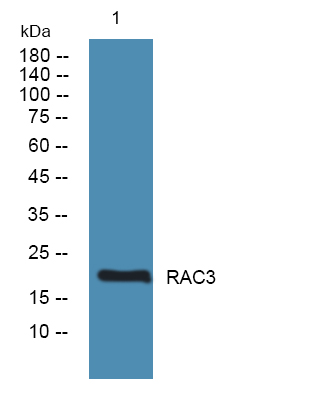RAC3 Polyclonal Antibody
- Catalog No.:YN1163
- Applications:WB;ELISA
- Reactivity:Human;Mouse
- Target:
- RAC3
- Fields:
- >>MAPK signaling pathway;>>Ras signaling pathway;>>Rap1 signaling pathway;>>cAMP signaling pathway;>>Chemokine signaling pathway;>>Sphingolipid signaling pathway;>>Wnt signaling pathway;>>Axon guidance;>>VEGF signaling pathway;>>Focal adhesion;>>Adherens junction;>>Natural killer cell mediated cytotoxicity;>>B cell receptor signaling pathway;>>Fc epsilon RI signaling pathway;>>Regulation of actin cytoskeleton;>>Yersinia infection;>>Human cytomegalovirus infection;>>Human immunodeficiency virus 1 infection;>>Pathways in cancer;>>Colorectal cancer;>>Pancreatic cancer;>>Choline metabolism in cancer;>>Viral myocarditis;>>Fluid shear stress and atherosclerosis
- Gene Name:
- RAC3
- Protein Name:
- Ras-related C3 botulinum toxin substrate 3 (p21-Rac3)
- Human Gene Id:
- 5881
- Human Swiss Prot No:
- P60763
- Mouse Swiss Prot No:
- P60764
- Immunogen:
- Synthesized peptide derived from human protein . at AA range: 80-160
- Specificity:
- RAC3 Polyclonal Antibody detects endogenous levels of protein.
- Formulation:
- Liquid in PBS containing 50% glycerol, and 0.02% sodium azide.
- Source:
- Polyclonal, Rabbit,IgG
- Dilution:
- WB 1:500-2000 ELISA 1:5000-20000
- Purification:
- The antibody was affinity-purified from rabbit antiserum by affinity-chromatography using epitope-specific immunogen.
- Concentration:
- 1 mg/ml
- Storage Stability:
- -15°C to -25°C/1 year(Do not lower than -25°C)
- Observed Band(KD):
- 21kD
- Background:
- The protein encoded by this gene is a GTPase which belongs to the RAS superfamily of small GTP-binding proteins. Members of this superfamily appear to regulate a diverse array of cellular events, including the control of cell growth, cytoskeletal reorganization, and the activation of protein kinases. Alternative splicing results in multiple transcript variants. [provided by RefSeq, Oct 2015],
- Function:
- function:Plasma membrane-associated small GTPase which cycles between an active GTP-bound and inactive GDP-bound state. In active state binds to a variety of effector proteins to regulate cellular responses, such as cell spreading and the formation of actin-based protusions including lamellipodia and membrane ruffles.,induction:Expression down-regulated in quiescent fibroblasts and clearly induced by serum stimulation.,similarity:Belongs to the small GTPase superfamily. Rho family.,subcellular location:Membrane-associated when activated. Co-localizes with NRBP to endomembranes and at the cell periphery in lamellipodia.,subunit:Interacts with the GEF protein DOCK7, which promotes the exchange between GDP and GTP, and therefore activates it. Interacts with C1D.,tissue specificity:Highest levels in brain, also detected in heart, placenta and pancreas.,
- Subcellular Location:
- Cytoplasm. Endomembrane system. Cell projection, lamellipodium. Cytoplasm, perinuclear region. Cell membrane. Cytoplasm, cytoskeleton. Membrane-associated when activated. Colocalizes with NRBP to endomembranes and at the cell periphery in lamellipodia. Colocalized with CIB1 in the perinuclear area and at the cell periphery.
- Expression:
- Highest levels in brain, also detected in heart, placenta and pancreas.
- June 19-2018
- WESTERN IMMUNOBLOTTING PROTOCOL
- June 19-2018
- IMMUNOHISTOCHEMISTRY-PARAFFIN PROTOCOL
- June 19-2018
- IMMUNOFLUORESCENCE PROTOCOL
- September 08-2020
- FLOW-CYTOMEYRT-PROTOCOL
- May 20-2022
- Cell-Based ELISA│解您多样本WB检测之困扰
- July 13-2018
- CELL-BASED-ELISA-PROTOCOL-FOR-ACETYL-PROTEIN
- July 13-2018
- CELL-BASED-ELISA-PROTOCOL-FOR-PHOSPHO-PROTEIN
- July 13-2018
- Antibody-FAQs
- Products Images

- Western blot analysis of lysates from A431 cells, primary antibody was diluted at 1:1000, 4°over night



